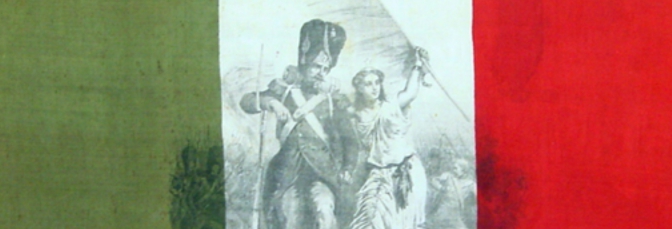Museo Civico del Risorgimento
Piazza Carducci 5
40125 Bologna
tel. +39 051 347592 (reception and ticket office)
Offices
Via de' Musei 8
40124 Bologna
tel. and fax +39 051 225583
e-mail
Library of Museo Civico del Risorgimento
Via de' Musei 8
40124 Bologna
tel. and fax +39 051 225583
e-mail
Certosa
Via della Certosa 18
40133 Bologna
tel. and fax +39 051 225583
e-mail

The exhibition space is organized into five sections based on chronology:
1. The Napoleonic era (1796-1814)
2. European Restoration (1815-1848)
3. Italian Unification (Il Risorgimento - 1848-1860)
4. United Italy (1860-1914)
5. Bologna at war (1915-1918)
There is also a special section dedicated to philately and the history of the postal system.
The Napoleonic Era
With the arrival of the French troops under General Bonaparte, Bologna became acquainted with the legal trappings of a modern state, and society as a whole was pushed toward the acquisition of a new political and economic culture.
European Restoration
The authoritarian rule in those years did not prevent the emergence of an insuppressible need for growth and development of production. The aborted revolution of 1831 revealed all the weaknesses of the Carbonari and secret societies, often overly confined within a municipal-level orientation. But this failure was precisely what sowed the seeds of the political activism of Giuseppe Mazzini.
The Epic of Italian Unification
These were the decisive years for Italian Unification, the years of the Wars of Independence and the Expedition of the Thousand, of Giuseppe Garibaldi and his legend. But for Bologna they were also the years of Ugo Bassi – the most popular figure in the Bolognese Risorgimento – and of the battle of 8 August 1848.
United Italy
While political unification was one step closer to completion with the acquisition of the Veneto and Rome, the newly fledged state had to cope with completely novel and decisive issues. Intense economic development, the need for universal public education, the growing tension among the various political and social powers, increasingly charged conflicts of ideas and interests, and the development of a new urban makeup all represented challenges with which the Bologna community had to grapple in those decades.
Bologna at war
Trumpeted as the "Last War of Independence", the First World War was a completely novel event for the enormous amounts of resources involved, for the new devastating weaponry, and for the social, economic and political upheaval it brought. On the other hand, it was also a sort of test bench for Bolognese society, which proved capable of efficient self-government and responding to the "developments" that the conflict wreaked upon the local population.
Philately and Postal History Section
This Section exhibits the collection donated to the Museum by its namesake, Giorgio Tabarroni (1921-2001), historian of science who also cultivated an interest in stamp collecting and in the history of the postal system. The first part of the exhibit includes stamps from the historic states of Italy, of the Kingdom and Republic of Italy (up to the 1960s), the Italian islands in the Aegean Sea, the lands disputed by Italy and Austria during WWI, and of Fiume (Bijeka).